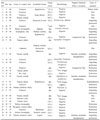Abstract
Purpose
To determine the risk factors of corneal ulcers that require eyeball removal even when properly managed.
Methods
We performed a retrospective review of 30 patients (30 eyes) who were diagnosed with corneal ulcers and underwent eyeball removal, even though their cases were properly managed, between 1990 and July, 2005. The Patients included of 14 males and 16 females. The mean age of the patients was 61.6±12.2. The ages of 20 patients were between 60 and 79.
Results
Unknown (13/30 [43.4%]) was the most commonly identified predisposing factor. The other predisposing gactors were ocular trauma (10/30 [33.3%]); bullous keratopathy (3/30 [10%]); keratoplasty (1/30 [3.3%]); pterygium excision (1/30 [3.3%]); history of Mooren's ulcer (1/30 [3.3%]); and bee sting (1/30 [3.3%]). The visual acuity at the time of evisceration was LP (-) (14/30 [46.7%]); LP (+) (4/30 [13.3%]); and hand motion (12/30 [40%]). Organisms were cultured in 7 patient (23.3%). Among these patients, funguses were cultured in 4 patients, and bacteria were cultured in 3 patients. The most common causes of evisceration were perforation (13/30 [43.3%]); pain (7/30 [23.3%]); impending perforation (7/30 [23.3%]); phthisis bulbi (1/30 [3.3%]); and endophthalmitis (1/30 [3.3%]).
References
1. Peyman . Principles and Practice of Ophthalmology. 1980. 2nd ed. Philadelphia: WB Saunders company;285–286.
2. Korea external eye disease society. Cornea. 2005. 2nd ed. Korea: Il-Jo gak;98–106.
3. Lee SR. Ophthalmic plastic and reconstructive surgery. 2004. 1st ed. Korea: Korean Society of ophthalmic plastic and reconstructive surgery;430–433.
4. Lee JH, Lee TW. Study on the pathogens of corneal ulcer. J Korean Ophthalmol Soc. 1981. 22:745–750.
5. Shim IC, Oh JS. A clinical observation of bacterial and fungal corneal ulcers. J Korean Ophthalmol Soc. 1982. 23:915–919.
6. Yun YS, Tchah SW, Joo CK, et al. Epidemiology of Infectious Keratitis (2): A multi center study. J Korean Ophthalmol Soc. 2001. 42:228–247.
7. Han YH, Han TW, Choi SH, et al. Epidemiology of infectious keratitis: A multi-center study. J Korean Ophthalmol Soc. 1998. 39:1633–1651.
8. Miedziak AI, Miller MR, Rapuano CJ, et al. Risk factors in microbial keratitis leading to penetrating keratoplasty. Ophthalmology. 1999. 106:1166–1170.
9. Kim YS, Lee SB, Chung WS. The causative organisms and therapy of corneal ulcers. J Korean Ophthalmol Soc. 1994. 35:1171–1177.
10. Bourcier T, Thomas F, Borderie V, et al. Bacterial keratitis: predisposing factors, clinical and microbiological review of 300 cases. Br J Ophthalmol. 2003. 87:834–838.
11. Keay L, Edwarks K, Naduvilath T, et al. Microbial keratitis: predisposing factors and morbidity. Ophthalmology. 2006. 113:109–116.
12. Butler TK, Spencer NA, Chan CC, et al. Infective keratitis in older patients: a 4 year review, 1998-2002. Br J Ophthalmol. 2005. 89:591–596.
13. Stehr-Green JK, Bailey TM, Visvesvara GS. The epidemiology of acanthomoeba keratittis in the United States. Am J Ophthalmol. 1989. 107:331–336.
14. Arffa RC. Grayson's disease of the cornea. 1991. 3rd ed. St. Louis: Mosby;–166.
15. Han YH, Lee DJ, Kim MS, et al. Epidemiology of fungal keratitis in Korea: A multi-center study. J Korean Ophthalmol Soc. 2000. 41:1499–1508.
16. Scott IV, Flynn HW Jr, Feuer W, et al. Endophthalmitis associated with microbial keratitis. Ophthalmology. 1996. 103:1864–1870.
17. Shah-Desai SD, Tyers AG, Manners RM. Painful blind eye: efficacy of enucleation and evisceration in resolving ocular pain. Br J Ophthalmol. 2000. 80:437–438.




 PDF
PDF ePub
ePub Citation
Citation Print
Print








 XML Download
XML Download